
All lovers of cats once faced with the issue of sterilizing their pet or not. Our grandmothers, having 2-3 cats in their house, were not tormented by such a question, because although cats brought kittens every year, natural selection did its job: cats lived 4-6 years and more than three in the household still did not have . In the last resort, each village had its own Gerasim. At present, we have built pets in the rank of full members of the family and can not solve the problem with kittens in a barbaric way. In this matter, veterinary medicine meets and offers such operations as castration in cats and sterilization in cats.
Sterilization is subjected to animals for two main reasons.
- During estrus, the cat behaves inadequately and aggressively, which disrupts the normal course of life of the whole family. In addition, the owners are frightened by the very fact of the appearance of kittens.
- Sterilization is indicated to the animal as prescribed by the doctor. This happens when mastopathy, tumors of reproductive organs.
It is believed that such an operation should be performed after the first birth. In fact, in each case, it is individual and only a veterinarian can determine the timing of the operation.
Before visiting a doctor, you must:
- to acquire a blanket which the animal will wear after the operation;
- prepare a sheet or diaper on which the cat will be in the first 24 hours after the operation;
- take with you a portable basket or a carry-over, the main thing is that the bottom should be rigid, and also a package and special wet wipes in case the animal will vomit after anesthesia.
The cat needs to be fed 12 hours before the forthcoming procedure, and the water should be given no later than three hours before the operation. it will reduce the burden on the heart and ensures that the cat will carry the operation easier. For the same reason, the operation is scheduled for the morning. In addition, it will be more convenient for owners to take care of an animal in the first 12 hours after sterilization.
Care of a cat after sterilization
The duration of the sterilization operation is about one hour. The owners usually do not allow this procedure and they wait in the waiting room. At that time you can get detailed advice on how to care for a cat after sterilization.
From anesthesia, the animal can go from 2 to 12 hours. For an organism this is the strongest stress, therefore at this time the cat can stir up. It is better to be ready for this immediately and take a bag and napkins with you to the veterinary clinic.
Transporting the animal in public transport will hardly work, so it is necessary to take a taxi. In a bag for transportation it is better to lay a diaper, and in a cold season it is possible to take advantage of a warmer, as at a cat the heat exchange because of a narcosis will be broken. It is important that the bottom of the carrying is stiff and does not bend under the weight of the calf.
Place for an operated cat
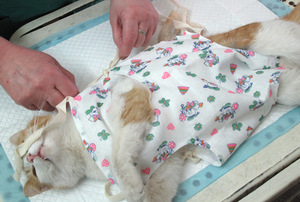 At home, you also need to arrange an animal on a straight surface. It is necessary to avoid high places. For an animal that is anesthetized, this can be dangerous. Soft warm litter is better to lay with disposable non-wetting diapers or sheets. It is necessary to provide the cat with heat. It can be a blanket, a hot-water bottle or something else. Next to the couch, you must have fresh water. Behavior of pets will be inadequate for the first 12 hours after sterilization:
At home, you also need to arrange an animal on a straight surface. It is necessary to avoid high places. For an animal that is anesthetized, this can be dangerous. Soft warm litter is better to lay with disposable non-wetting diapers or sheets. It is necessary to provide the cat with heat. It can be a blanket, a hot-water bottle or something else. Next to the couch, you must have fresh water. Behavior of pets will be inadequate for the first 12 hours after sterilization:
- the cat can have eyes open, but in fact she is sleeping. To the eyes do not dry out, they must be dripped with a special remedy before the operation. If this is not done, the veterinarian may advise you to blink for her, that is, carefully close her eyelids every 5 minutes;
- the animal can begin to walk, while bumping into objects and falling. Just return it to the prepared place. A cat under the influence of anesthesia does not realize its actions and the dangers they caused, so in no case do not arrange a couch for them on the tables, sofas and other surfaces that are from the floor above 10 cm. Moreover, when she moves away from anesthesia, she will be painfully climbing to a higher place for rest;
- under the influence of drugs the animal can go to the toilet under itself. Just wipe it with special wet wipes and change the diaper.
Reconstructive postoperative period
After the operation, the veterinarian will certainly explain how to take care of the cat after sterilization. Perhaps, antibiotics will be prescribed. They can be put to the animal on their own, and can be carried to the clinic. It is better to buy insulin syringes for injections. They have a more delicate needle and the animal will not feel any discomfort.
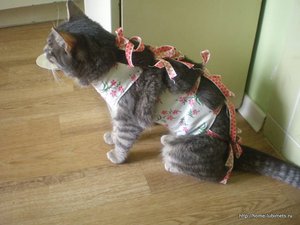 The seam should be treated twice a day green or special composition, which will be sold immediately after surgery in the pharmacy of the veterinary clinic. Care should be taken to ensure the cleanliness of the postoperative suture. It will not be difficult to do this, since before the sterilization of the tummy, the cat will be beaten with nails. For this procedure, you will need two people: one will process the seam, and the second will hold the animal so that it does not break out and does not injure itself. For dressing, the blanket should be removed or weakened in order to have access to the seam. After treatment, the protective corset is dressed again. In case of inflammation, you need to see a doctor immediately.
The seam should be treated twice a day green or special composition, which will be sold immediately after surgery in the pharmacy of the veterinary clinic. Care should be taken to ensure the cleanliness of the postoperative suture. It will not be difficult to do this, since before the sterilization of the tummy, the cat will be beaten with nails. For this procedure, you will need two people: one will process the seam, and the second will hold the animal so that it does not break out and does not injure itself. For dressing, the blanket should be removed or weakened in order to have access to the seam. After treatment, the protective corset is dressed again. In case of inflammation, you need to see a doctor immediately.
It is very important that the patient does not take off the blanket for the first two weeks after the operation, otherwise there is a risk that the seams may disperse or any complications may arise. It is better to restrict your pet's activity during this period, not allow them to jump on high surfaces or, conversely, jump off them. In general, there are no special environmental requirements, but if the cat lived in the yard before the operation, it should be taken to the house for two weeks of recovery to ensure proper sanitary standards.
Cat food in the postoperative period
In the first two days after the operation, the cat is unlikely to show interest in food, while fresh water should always be near the animal. If the appetite does not appear on the third day, you should urgently contact the veterinarian. You can feed your cat with its usual food. The only thing that can be changed in the diet is change over from dry to wet
Sterilization is a medical manipulation that makes a cat permanently or temporarily incapable of reproducing offspring.
Why do I need to sterilize?
If you do not want the cat to have kittens, then it's best to sterilize it.
Some people consider this operation inhuman. But if you imagine how the cat will suffer from hormonal "bursts" against which serious diseases and psychoemotional exhaustion can develop, then sterilization will seem very much even by a gentle procedure. And not only for the cat, but ultimately for its owner: after the operation the animal behaves much calmer, and look for a cat.
And do not "build" or otherwise get rid of kittens.
How is this operation performed?
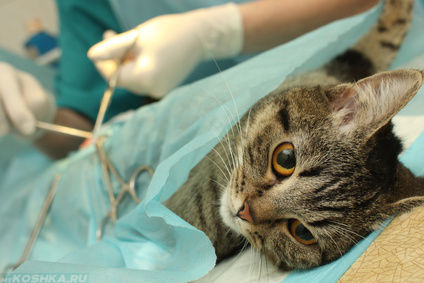
Sterilization should be carried out in a veterinary clinic with strict adherence to the conditions of antiseptic. The operation lasts about 40-50 minutes. After the end of the operation, the "withdrawal" from anesthesia lasts about 3 hours. Then the doctors of the clinic give the cat to the owner.
Three ways to sterilize a cat
- Removal of the ovaries , often together with the uterus (old, but proven and most often used in veterinary medicine).
- Ligation of fallopian tubes . Prevents from pregnancy, but does not relieve the characteristic sexual behavior of the cat. Therefore, this method is rarely used.
- Chemical (temporary) sterilization - implant implantation with a sex hormone blocking drug under the skin. The effect lasts from six months to a year.
Temporary sterilization is often practiced for cats in nurseries. And also it is justified by people for whom breeding cats is business. For example, for some period it is not necessary for the cat to become pregnant, but after a few months it is expected to be viscous.
Care of a cat after sterilization
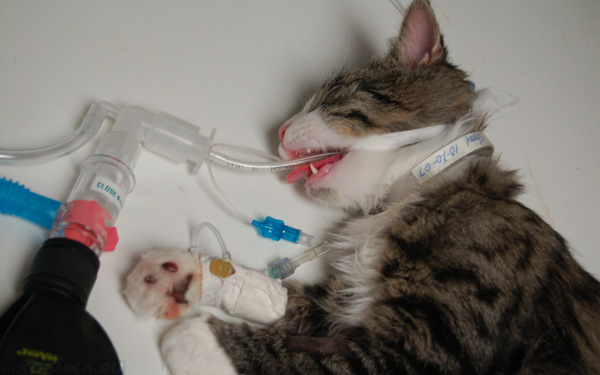
The cat is anesthetized, preparing it for a sterilization operation.
The postoperative period is the time from the arrival of the animal into consciousness after surgery until all symptoms of anesthesia and the healing of the postoperative wound disappear.
The course of the postoperative period in a cat depends on several factors:
- Anesthetic , which was given to the animal (intravenous or inhalation). Intravenous is more expensive and its introduction involves some technical difficulties, but it is considered the most effective and safe;
- Age of the cat . Of course, it's better to do sterilization right after the estrus or after the first birth. A later operation or operation after several litters is transferred worse and is associated with a greater risk of complications;
- Concomitant pathologies . Long-term viral infections (eg,), respiratory diseases and chronic diseases of the gastrointestinal tract complicate and extend rehabilitation after any surgical intervention.
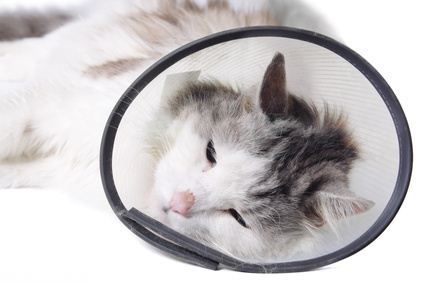
How to make anesthetic injection yourself
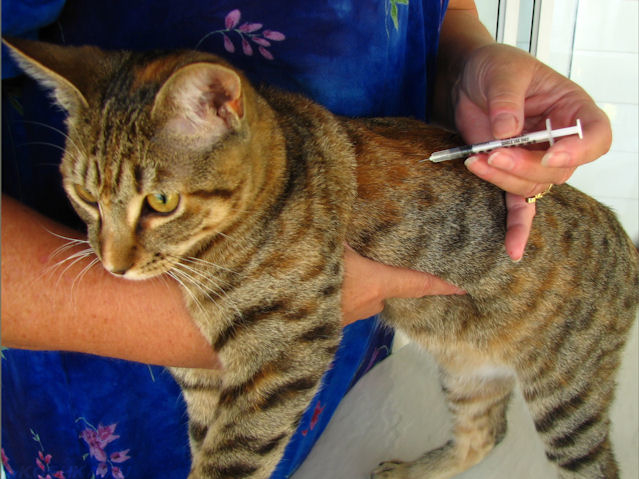
If you know how to prick pricks, then you can give her pain medication. If you do not know how to prick, it's never too late to learn.
You can ask the doctor of the veterinary clinic to show the technique of performing the manipulation. There are two places for the administration of the drug: withers (subcutaneous injections) and hamstrings (intramuscular injections).
Application of ointments and treatment of the seam after sterilization
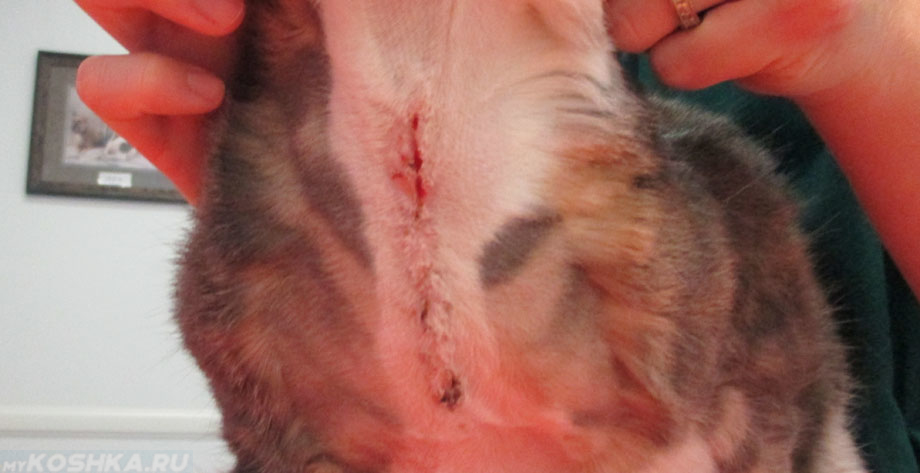
The seam after the operation must be treated.
The use of ointments is undesirable. They have a fatty base that blocks the access of oxygen to the skin. A serious anaerobic infection can develop in the wound.
- Veterinarians say that you should not overdo with the treatment of the suture, if there is no redness or swelling in the surrounding tissues.
- Postoperative edema of tissue - slightly rises above the surface of the skin. Soon the wound is overgrown with a light pink or white granulation tissue. It is very gentle, therefore it is necessary to avoid traumatizing the skin during this period. Gradually, the "young" connective tissue is replaced by yellow or light brown - a scar is formed.
- Sometimes cats do not react to the seam, but they can start licking and even biting. It is necessary to wrap the back of the cat's body with a cotton cloth, or you can sew a coverall.
- Active movements of the animal should be reduced to a minimum - the edges of the seam can disperse, bleeding will begin.
conclusions
Although sterilization is not a complicated surgical manipulation, it is not worth it to relax the cat's owner. It is wise to approach the issues of postoperative management of an animal with the aim of preventing complications and long-term consequences.
The owner of the cat must know how the animal behaves after sterilization to understand what is the norm, and when to consult a veterinarian.
Exit from anesthesia
Three different methods of anesthesia are used for surgical intervention. The condition of the cat after the sterilization operation largely depends on what kind of anesthesia was used.
- Inhalation (gas) anesthesia. One of the most effective methods of general anesthesia, after which the cat comes to life very quickly - almost immediately, as an anesthetic mask is removed from the muzzle. It is used rarely because of the high cost and lack of necessary equipment in hospitals.
- Miorelaxants in combination with epidural anesthesia. This kind of anesthesia is easily tolerated by a cat, and the full exit from it takes a maximum of 8 hours. However, there are risks of postoperative complications, during which the sensitivity and motor activity of the hind limbs is impaired. Restoring everything can take up to 2 days.
- Miorelaxants with analgesics - are used most often, but the output from such anesthesia can take from 6 hours to a day.
The behavior of the cat after the sterilization operation at the time of withdrawal from anesthesia may be the most unexpected:
- disrupted the coordination of movement (unstable and unsteady gait);
- inadequate behavior - from passive indifference to everything to open aggression;
- the desire to escape somewhere;
- inadequate response to surrounding people and what is happening around;
- disorientation;
- a clear desire to hide somewhere or hide in a dark corner;
- unexplained meowing;
- vomiting;
- uncontrolled urination.
General condition and behavior of the cat in the first days after surgery
How does the cat feel after sterilization, depends:
- from the age of the animal when the operation was performed;
- whether operative intervention was emergency or planned;
- what kind of anesthesia was used.
In the first hours, post-amniotic hypothermia can occur because of disturbances in temperature exchange, which is manifested by cooling of the extremities. At home it is advisable to lay the cat on a slightly warm water bottle, covering it with something.
After surgery, the cat will be wearing a postoperative bandage or a protective collar so that the animal does not have access to the seam and wound. When the pet is recovering from anesthesia, she will try in every possible way to disrupt all these adaptations. It is enough to watch, that the animal does not injure itself. Get used to everything the animal for a day or two.
A cat after sterilization can exhibit aggressive behavior. This is due to an increased response to ambient noises and numerous people around as the senses return to their full-time work. It is enough to put the cat in an isolated room or for a while to close in the carry.
After anesthesia, the animal can feel pain. It is recommended to prick or to give an analgesic. The main signs of postoperative pain in a cat:
- increased aggression in any attempt to contact with it (for example, take in hand);
- dilated pupils;
- immobility in one position (mostly on the abdomen, bending the paws under it);
- a concentrated look at one point;
- complete refusal of food.
Natural emptying, appetite and thirst
We need to make sure that the cat in the first day after the operation must go to the toilet. Frequent trips to the toilet should be alerted, as well as a complete absence of the emptying of the bladder and intestines. With reflex postoperative constipation (no defecation until 3 days), you will need to give a laxative, after consulting with a veterinarian.
Normal active appetite and thirst should return to the second-third day. By this time, the cat already shows a normal interest in food and drink, so he already asks for food and drinks on his own. Important: it is not recommended for a cat to eat a lot after sterilization. What if I often ask for food? It is enough to reduce portions of food. Sterilized cats are prone to obesity due to increased appetite against hormonal rearrangements, so the diet and feeding regimen will have to be monitored more carefully than before the operation.
Seams and general restoration
Usually, during sterilization, intradermal sutures are applied which do not need to be removed. External seams are removed for 7-10 days, but not later than the 12th, in order to prevent the suture material from growing into the skin and surrounding tissues. Throughout the healing time of the postoperative wound, the joint must be clean, dry, without signs of inflammation.
How long the cat recovers after sterilization, will depend on the conditions in which it is after the operation, as well as the general state of her health. Young and healthy cats recover faster than the elderly, burdened by additional diseases. Usually, by the 5th-7th day of surgery, only the presence of a postoperative collar or blankets reminds, but otherwise the animal should already lead its usual lifestyle. Complete recovery of the cat after sterilization is observed after 3-4 weeks.
First let's figure out what the sterilization procedure is and what it is for.
During this procedure, the cat's sexual glands are surgically removed, which leads to suppression of sexual activity. After this operation, the biochemical processes in the cat's body change, which basically are responsible for the metabolism.
- Uterus removal;
- Ligation of fallopian tubes;
- Removal of the uterus and ovaries.
The first two methods of sterilization have significant disadvantages - the preserved ovaries continue to fulfill their function. As a result, the cat remains a need to walk, so for a month she will loudly meow and annoy those of her masters. In addition, during these operations, a cat may develop a false pregnancy.
In this regard, most often complete removal of the uterus with the ovaries. This operation is called ovariectomy, it helps suppress the function of producing hormones. As a result, the cat completely stops sexual activity.
Why sterilize cats?
To this procedure resorted to in two cases:
- Sometimes the owners do not want their cat to bring offspring. Perhaps this is not humane, but everyone has their own thoughts on this matter;
- In addition, sterilization may be necessary from medical indications, for example, in tumors of the uterus or ovaries, with advanced cases of endometriosis. In such cases, medications often do not give results, so surgical intervention is the only solution.
This operation is not considered difficult, it lasts from 40 minutes to 1.5 hours. The presence of a cat owner in the operation is not necessary.
How should I take care of the cat after the sterilization procedure?
After surgery, the cat is not recommended to be taken from the clinic home by public transport, therefore, in extreme cases, you will have to call a taxi. For transportation it is necessary to use a carry-over or a special bag. Bottom lay the oilcloth, and on top of her lay a diaper. The cat should be sheltered. You can even use a heating pad. In the pharmacy you can buy a self-heating salt pad.
So, your pet is at home.
In the first knocking the animal will be sluggish, it will not show interest in anything, do not be afraid, it is quite normal, because the cat is under the influence of narcotic drugs.
After the operation, the cat needs careful care, the owners should show more attention to it. It is advisable to be on the first day after the operation of the cat to be next to your pet. The first few hours she sleeps or will be dozing .
A cat can tear, it can also "go to the toilet under her," if this state does not last long, it is also not a pathology.
The owner of the sterilized cat should do the following:
- Provide the animal with complete peace. The cat should be put in a warm place, on the litter and covered with a blanket. After the operation, it will freeze, as the thermoregulation of the body changes. At the same time, the cat feels cold to the touch, it should not be frightened. Soon the temperature of her body normalizes;
- Next to the cat, you must put a bowl of pure water. Most often in the first day after sterilization, the animal does not have an appetite. But, when the cat does not start eating the next day, this is the basis for anxiety. I'll have to take her to the vet immediately;
- About 2-3 days after the operation, it is best to feed the dieter with digestible diet products;
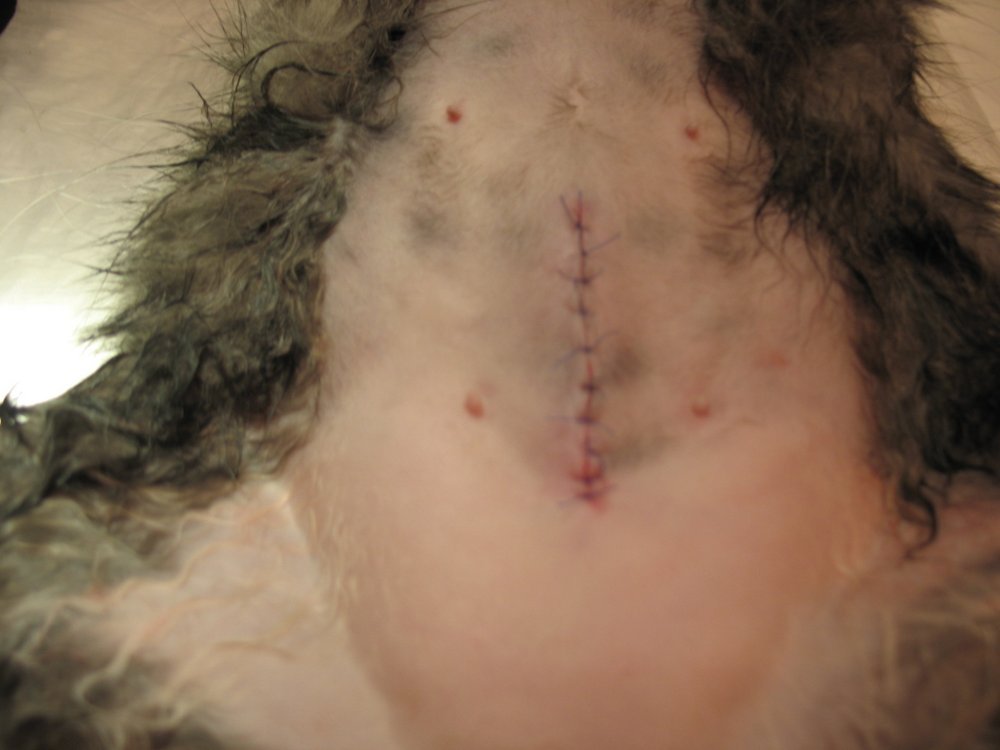
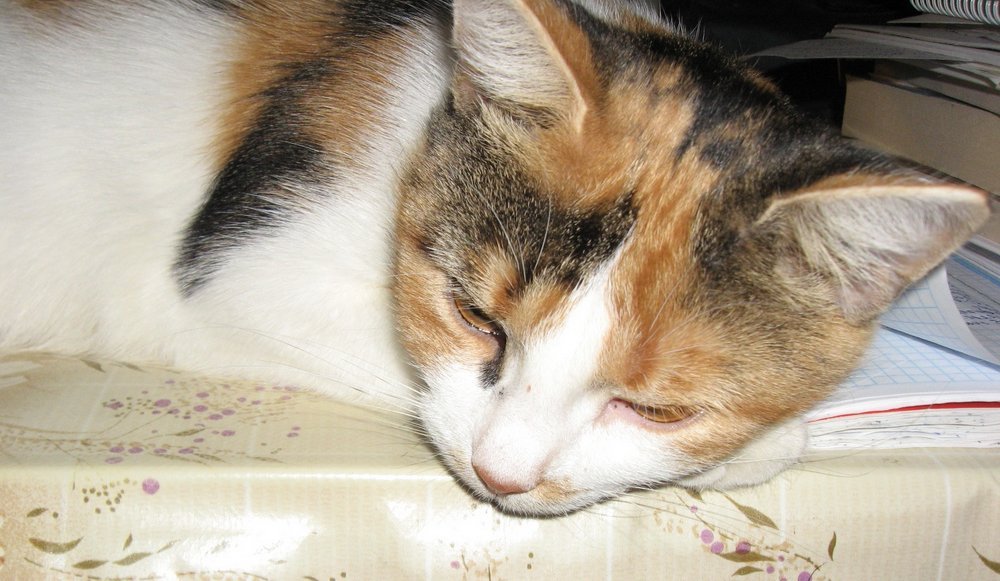
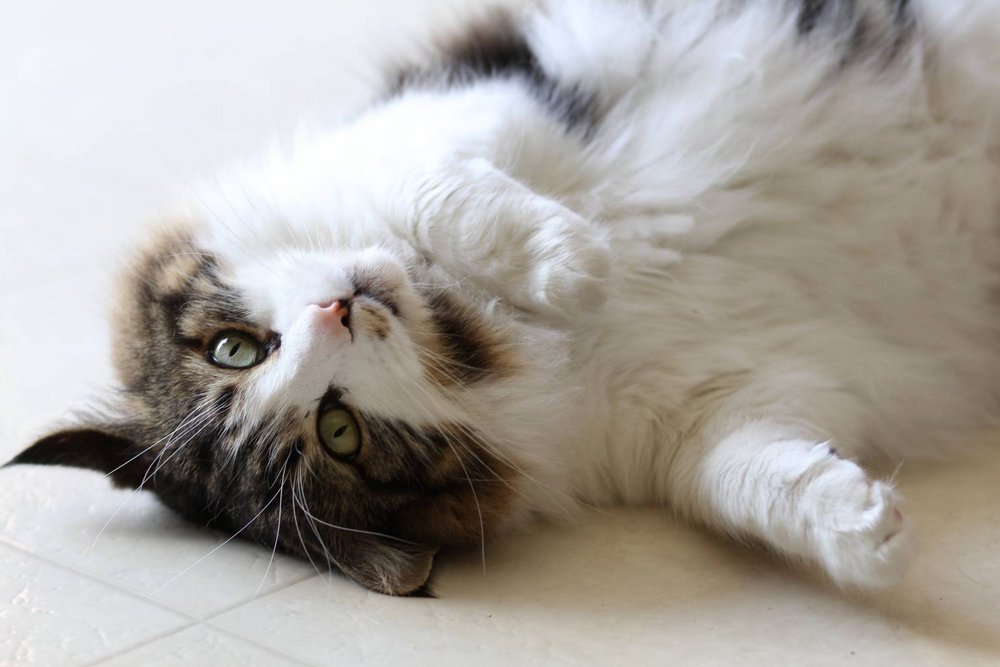
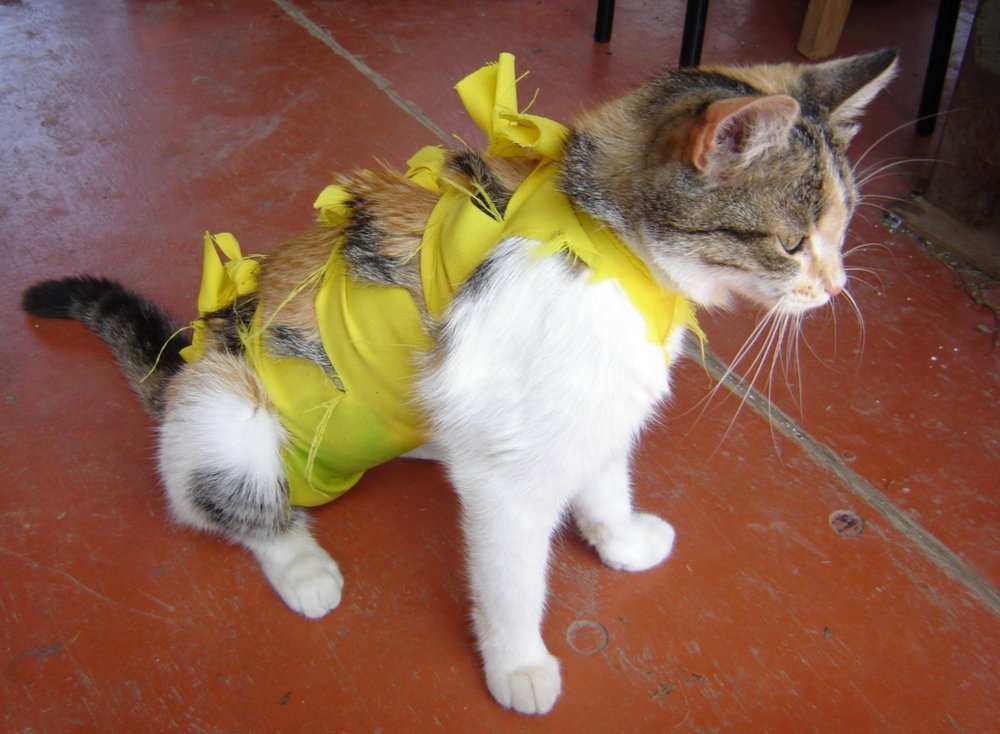
- The animal must be fed intensively, while the vitamin-mineral complex is introduced into the diet, this allows you to recover more quickly after the operation.
This, as for the creation of comfortable conditions, but still the owner will need to perform therapeutic and prophylactic measures and handle the seams:
- Seams should be treated several times a day with 3% hydrogen peroxide, and after a solution of brilliant green;
- That the cat does not lick the seam and does not bite the thread, it is recommended to put a bandage or a blanket on it;
- Make sure that the seam is dry, not choked and does not emit a bad smell;
- It may be necessary to prick the animal antibiotics for 5-7 days.
If you follow the above tips, your cat will easily survive the postoperative period and will quickly recover.
If you find a bug, please select the text fragment and click Ctrl + Enter.
The owners of cats are increasingly thinking about sterilizing their pet with the goal of maintaining health. A qualified doctor will not allow postoperative complications and will dedicate the owner to all the subtleties of caring for the animal. However, it is not uncommon for a veterinarian not to provide owners with basic information for certain reasons. Then the question arises as to how to take care of a cat after sterilization.
Factors affecting the recovery of a cat after sterilization
Sterilization is a basic operation that can be carried out by an experienced specialist. To understand how long the cat will recover, study the main aspects.
- The most important thing is timely access to a specialist. If you sent the animal to sterilize on time, taking into account the recommendations of the doctor, then the pet will recover quickly. The optimal period is the time when the cat has not yet had estrus, pregnancy and childbirth. In this case, the tissues will recover in a short space.
- Rehabilitation depends on the age of the cat. Young individuals have strong health in contrast to the elderly. In cats, up to a year, all metabolic processes are at the optimum level. If you fed the animal well, vaccinated and given vitamins, there should be no problems with rehabilitation.
- The qualification of a veterinarian matters. For sterilization, only surgeons who have sufficient knowledge should be treated. An experienced doctor will perform the operation with a minimum tissue break, correctly put the seams. These aspects will lead to rapid healing of wounds.
- Restoration of the animal after sterilization also depends on the care that the owner will give to the pet. If you follow the recommendations of the veterinarian accurately, handle seams in a timely manner, feed and water the cat, the duration of rehabilitation will be reduced to a minimum.
- If a cat has any health problems, complications may occur after sterilization. A rise in body temperature, stitch consumption, and other ailments will increase the duration of recovery.
Care of the cat immediately after sterilization
- Extract. It is important to take with all responsibility to caring for the animal in the first hours after surgery. There are clinics that take the animal out of anesthesia, then in the awakened state, the owner is handed over. However, more and more doctors prefer to "write out" cats from the clinic in a state of narcotic sleep. In the latter case, the surgeon must necessarily give advice on care.
- Warmer. Being under anesthesia, the animal will increase breathing, but the pulse will become slower. At the same time, body temperature will fall by 2-3 degrees. In this state, the pet is susceptible to a sharp temperature drop, as well as drafts and cold. If you sent the animal for surgery in the winter or autumn, take care of an extra hot water bottle. From the back, place a bottle of warm water. During the entire transportation period, make sure that the container does not move to the operating wound. Otherwise, heat will cause bleeding.
- Transportation. In advance, take care of the carry bag with a firm bottom, with which you will transport the cat. Spray a disposable diaper into the cavity, put a soft cotton cloth over it (a sheet folded into several layers). Place the animal in the bag. It is important that the python lies on the right side. Cover it with a blanket or a warm blanket.
- Arrival home. After you arrive at your destination, leave the animal in the carry (if there is enough space in the bag). In other cases, lay a disposable diaper and a warm underlay (cloth) on the floor away from drafts. Do not leave the cat on the ground with a hill and too elastic surface (bed or sofa).
- Awakening. The cat was under general anesthesia throughout the road. The way out of a sleepy state depends on a number of aspects, such as the type and dose of anesthesia, the individual characteristics of the organism, the weight of the pet's body, etc. If we talk on average, the cat will wake up in 2-8 hours. At this time it is important to constantly watch the darling. After retiring from a dream, the cat will unconsciously move, jumping or escaping. To prevent the animal from getting injured, choose a completely safe place for the cat.
- Care of the eyes. After surgery, the veterinarian should give clear recommendations regarding the care of the animal. The thing is that when anesthetized, the eyes of cats remain open. Some owners are frightened, but have patience. To prevent the drying of the cornea, gently close the belly's eyelids at a frequency of 1 time in 30 minutes. You can do a light massage with eyelids, or drip cat drops (from drying out).
- Massage. Throughout the duration of the anesthesia, the cat should not be given water or food through strength. If the dream lasts too long, gently massage the paws and pads of the animal's fingers. Thus, you will accelerate the blood circulation throughout the body of the pet and prevent the flow of limbs.
The content and nutrition of the cat after sterilization
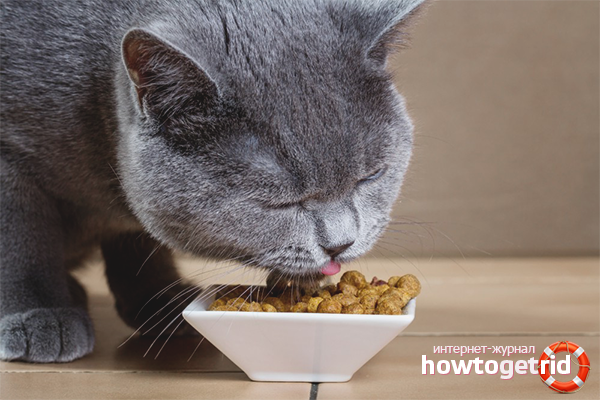
- When the darling comes away from anesthesia, she will begin to move more confidently. Offer a cat to eat, provide round the clock access to clean water.
- As for food, give the animal a special premium food with the appropriate mark "for sterilized cats." As a rule, the appetite returns to the end of the first or the beginning of the day's wake, following the operation.
- Some animals are sick after the first meal. Thus, anesthesia is reflected. After 2-3 days the cat will regain its appetite, digestion will be normalized.
- Doctors do not always give advice about feeding. In the first days, treat your pet with animal feed that has undergone surgery. If the cat used to eat ordinary food, increase the milk and boiled vegetables content in its diet.
- Watch how often the animal defecates. If the cat is constipated (it does not go to the toilet more than 3 days), treat the python 4 g. vaseline oil. It is impossible to put enemas or water a cat with laxatives without consulting a doctor. If the constipation does not go away after taking the oil inside, contact your veterinarian.
- Many experienced doctors put on a cat a blanket that prevents the licking of the wound by the animal itself. Also, the device protects the wound from dirt. After the sterilization, the blanket is allowed to be removed when the wound is completely healed. Too "meticulous" cats (constantly licking themselves) take 10-12 days, all the rest - 3-9 days.
Cat after sterilization: grooming
- Closely monitor the post-operative suture of the animal. Ask the veterinarian how to handle the slice. As a rule, it is necessary to rinse the joint with an alumina. In this case, no additional drugs are required.
- If the doctor said that the treatment of the suture is necessary, spend it after 2-3 days after the operation. To the wound quickly healed, use an antiseptic. Suitable is the usual "green", hydrogen peroxide or chlorhexidine, betadine, levomecol.
- In the first days after surgery, the seam can slightly swell, blush or become shiny, such phenomena are considered the norm. Often from the wound oozes a syphilis (a semitransparent liquid).
- The duration of the healing of the joint depends on a number of aspects. This includes the individual structure of animal tissues, the skill of the veterinarian, post-operative care, etc. If we take the average value, the cut is delayed after 10-12 days.
- Careful attention is paid to the seam on the fifth day of antiseptic treatment. It is important that the edges do not divide by more than 1 mm. Also, the wound should be dry, without pus and other fluid.
- Many doctors practice sterilization, in which the suture is applied with a resorbable material. Such threads do not need to be removed. If you wish to conduct the procedure of removal on your own, find out about the manipulations in more detail by the doctor.
- The technique does not present difficulties. You need to know how many stitches were applied. Armed with tweezers and scissors, sterilize the instruments. Pull the forceps with a pair of tweezers, cut one thread with scissors. Gradually get rid of the rest of the material.
Possible complications of the cat after sterilization
It is not always easy to sterilize. Unfortunately, in 20% of cases there are postoperative complications, which entail serious consequences.
You need to be alerted if you have the following symptoms:
- Absence of a cat's appetite for 4-5 days after the operation.
- Elevated body temperature (39.5 degrees) on the fifth day after sterilization.
- Apathy and drowsiness, which accompany the cat in the first 5 days.
- Puffy, red, bleeding, cuffed suture on the fifth day after surgeon intervention.
- Unbearable pain, in which the cat "yells" constantly.
The above signs indicate that rehabilitation is not going as well as it should. Consult a surgeon who performed the operation.
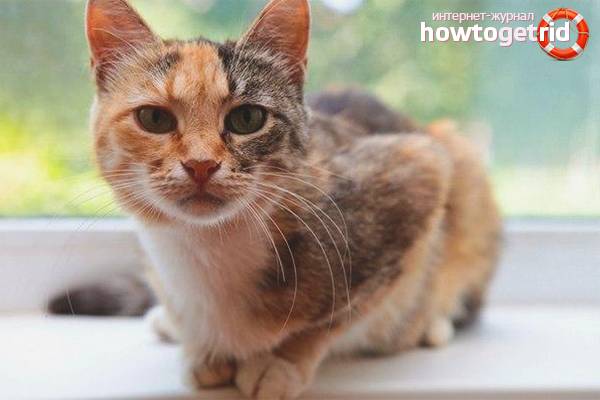
- Many owners of furry pets believe that after surgery the cat will become sluggish, fat, not cheerful. However, such profound statements are extremely erroneous. Sterilization positively affects the health of the animal and sexual behavior.
- So, after 1.5-2 months the hormonal background of the cat returns to the usual mark. It significantly stabilizes due to the reduction of hormones, which now remain at a minimum level.
- After this, the owner can notice the changed behavior of his fluffy girlfriend. The cat spends more time with the household, demanding caresses. She is less alone.
- The pet will not suffer because of the constant sexual instincts. A cat is more playful and receptive to a person, trying to be close.
- If you have previously raised the issue of settling a second pet, you can carry out the conceived after the complete rehabilitation of the first pet. The cat will be playful, friendly and caring towards a new member of the family.
If sterilization takes place during the cold season, take care of the plaid and the cat warmer. On arrival, do not place the operated ptomitsu on high surfaces, allocate her a place on the floor. Watch your eyes, provide 24-hour access to water. Buy a forage marked "For sterilized cats," in a timely manner, wash the seam. At the slightest sign of complications, take the animal to the vet.

